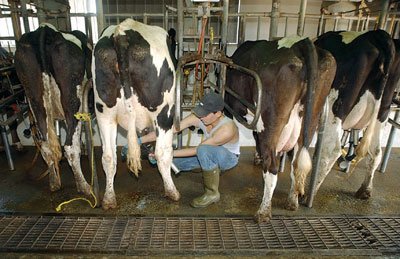Gilroy
– An east Gilroy dairy with a troubled environmental record has
shut down its operations, an apparent victim of financial and
regulatory pressures facing the state’s milk producers.
Gilroy – An east Gilroy dairy with a troubled environmental record has shut down its operations, an apparent victim of financial and regulatory pressures facing the state’s milk producers.
The roughly 600 head of cattle at Furtado Dairy Farm were simply gone April 6, when regional water regulator Mike Higgins arrived to inspect the property off Ferguson Avenue. Higgins, a regulator with the Central California Regional Water Quality Control Board, has closely monitored the 80-acre operation since farmer Manuel Furtado was slapped with a $30,000 fine two years ago for discharging wastewater into nearby Jones Creek.
Higgins said the dairy farmer was always “on the edge” in terms of keeping his wastewater ponds from overflowing into the creek, but ultimately, it appears that economic forces – and not environmental regulators – led his operation to shut down.
“Manny Furtado told me in March that he was trying to sell,” Higgins recalled. “He said ‘It’s the worst year I’ve ever had in the dairy business.’ ”
Furtado’s cousin, Kendra Fortino, confirmed that her cousin shut down the operation but could not elaborate on the reasons. She said she does not regularly speak with Furtado, who worked the land originally purchased by her grandfather in the 1950s. Fortino, now in charge of finding a new tenant, said the family has had no luck luring another dairy farmer to the site. Her uncle attempted to set up a smaller operation “of no more than 100” dairy cows, but could not find any local creameries or other milk processors to accept his milk.
“In order to have a new dairy on the premises, you have to have an agreement with a creamery, and they aren’t taking any clients right now,” Fortino said, adding: “The price of milk has gone up yet they’re claiming they have a surplus of milk.”
Fortino’s dilemma points to bigger troubles facing California’s dairy industry, according to Michael Marsh, chief executive officer of Western United Dairymen, in Modesto.
“The challenge in California right now is that plants have very limited capacity for processing milk,” Marsh said. “The permitting process for a new facility in the state is hugely burdensome. It’s not just difficult to get a dairy permit, but also difficult to get a processing permit in California. Consequently, when you have additional milk on the market, the processing capacity can’t handle the volume of milk we can produce.”
In Texas, for example, a permit to build a processing plant can be obtained in 45 to 60 days, Marsh said, whereas in California it takes as long as six years – not counting potential battles with environmental groups or local residents.
“(Last year) was a disaster for the diary industry in the state of California,” Marsh said. “It was a combination of three things: You had extraordinarily high feed costs, driven primarily by demand for corn-based ethanol production … At the same time in 2006, you had a relatively low milk price. … The other challenge that the farmers have had is new regulatory requirements that have been put on them.”
Instead of milking cows, many farmers spend their time slogging through paperwork and paying tens of thousands of dollars in regulatory fees. The burden has been especially hard on small farmers such as Furtado, according to Marsh.
“It has made them less competitive,” he said, “and in some cases pushed them out of business.”
In 2006, the state saw 63 dairies shut down; since the beginning of 2007, another 23 have shut down.
Still, California remains one of the leading milk producers in the country, contributing 21 percent of the nation’s milk supply, according to Steve Lyle, spokesman for the California Department of Food and Agriculture. In 2005, the state’s 1,970 licensed dairies produced $5.3 billion worth of milk – a jump of more than $1 billion from just two years earlier. After California, Wisconsin is the second leading milk producer, accounting for 13 percent of the country’s production.
For the moment, it remains unclear if the former site of Furtado Dairy will once again serve as home to a milk producer. Fortino has taken on the duty of finding a tenant and exploring options for the land. The area lies outside city limits on the east side of Llagas Creek, less than a mile from farmland targeted for a 1.5 million square foot outdoor mall by Westfield Corporation.
Though the city has no immediate plans to include the area in Gilroy’s growth boundary, officials have consistently resisted pressure from regional land-use regulators to draw permanent urban boundaries.
Fortino said it’s too early to predict whether her family’s land will continue as a farming operation or become part of a long-term development plan.
Said Fortino: “We’re still kind of reeling from, ‘OK, it’s not going to be a dairy, What are we doing now?’ ”














